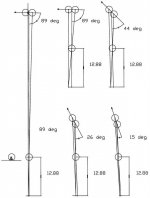Dr.Dave,
First, thanks for including my old post in your website. I have tried what I proffered then at the table. I have now modified my observations to include all cut angles. I ask you to remove the old post and replace it with the new one below if you find it has more value.
-----------------------------------------------------------------------------------
Here's another version shared by LAMas starting with a CTCP alignment, shifting based on the perceived distance to the OB center (instead of the CB edge), and pivoting back to the CB center (AKA, center-to-contact-point-to-center or CTCPTC):
1. Aim the center of the CB at the contact point on the OB that sends the OB to the pocket/target.
2. Parallel shift the cue to the center of the OB. Do this without regard for the CB. The shift will be a large distance when the CB and OB are close together and a small distance when the CB and OB are far apart - for the same cut angle. This is because the OB, being down-table, will appear to be a small[er] diameter than the CB which is in front of your eye/s.
This changing shift (distance) helps to reduce the trajectory/angle as the OB is separated from the CB – post pivot.
3. Pivot back from the new bridge location until the tip of the cue is aimed at the center of the CB and then shoot the shot. This gets you close to where the ghost ball should be.
The bridge is what you are comfortable with, say 12.0” or so behind the CB – no change in the bridge distance is necessary for different separations between the CB and OB.
Here are some examples of the same bridge pivot length (12.88”) being used for different cuts angles:
View attachment 164578
